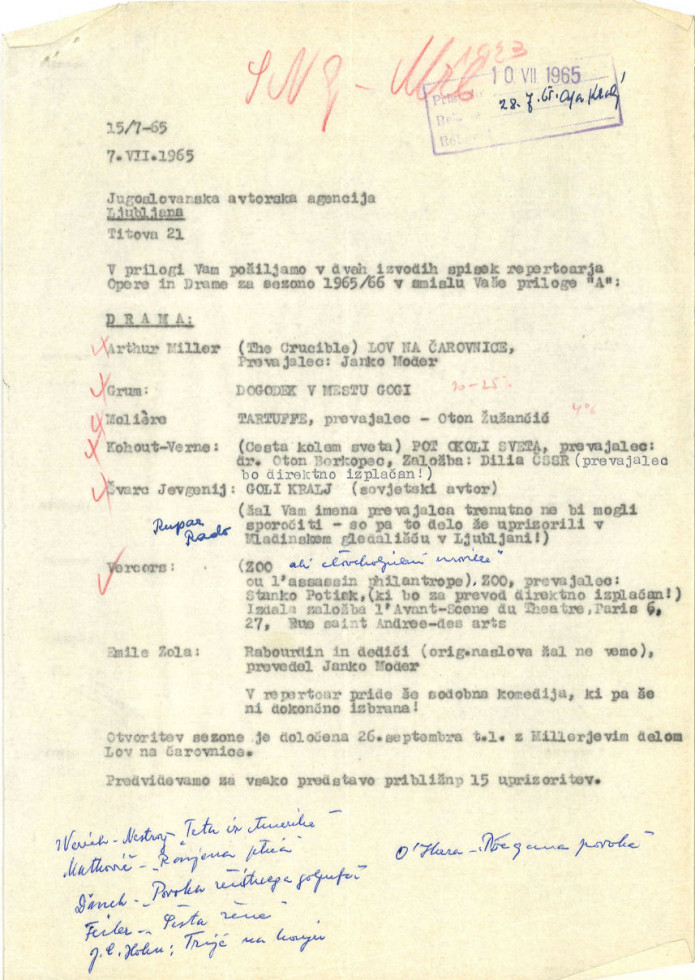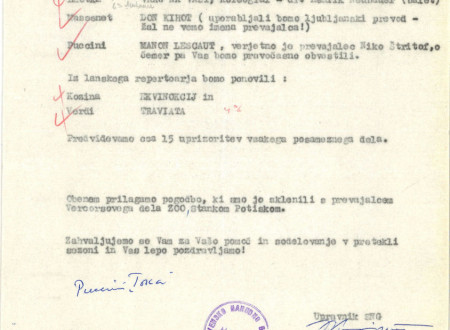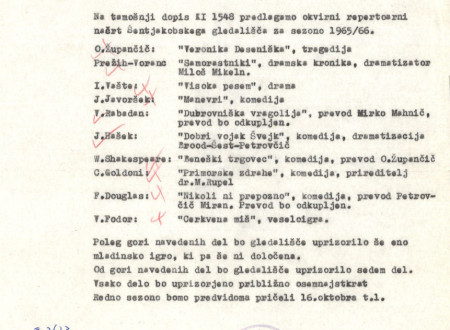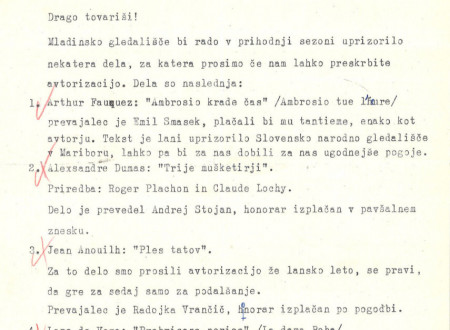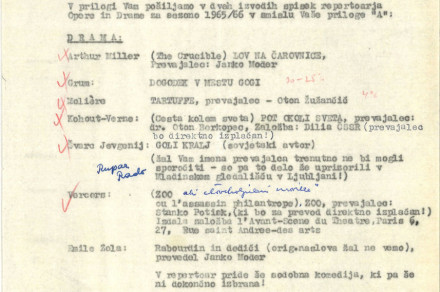Copyright and Royalty Payments
Not long ago, some records were found at the repository of the Archives of the Republic of Slovenia which turned out to be created between 1951 and 1970 by the Slovenian branch office of the Yugoslav Copyright Agency and its predecessors.
The Yugoslav Copyright Agency (YCA) was founded at the end of 1954 when the then Institute for Copyright Protection separated from their activities part of authors’ associations. Established with a mission to act as an agent in copyright related issues, the agency had its seat in Belgrade and branch offices in Zagreb, Ljubljana, Sarajevo and Skopje. Slovenian branch was founded in 1955 and its first manager was the poet, editor and lawyer Rado Bordon. It was located on the first floor of the Kavarna Evropa Coffee House next to the Figovec Inn (present-day Slovenska Road 47) where the Copyright Agency of Slovenia, which is the legal successor of the Yugoslav Copyright Agency – Slovenian branch office, has its headquarters even today. In 1956, the management of the Ljubljana office was taken over by the writer, translator and publicist Nada Kraigher who remained in charge until 1977. The Yugoslav Copyright Agency was financed by charging commission from the gross value of the royalties paid. The commission was at first set at 6 %, and was then gradually being reduced until finally reaching 4 % of the gross value of the royalties paid.
The work of the Yugoslav Copyright Agency and its branches was divided among the departments that covered various sets of copyright pertaining to certain groups of authors. The departments covered works of fine art, literature, theatrical works, patents and technical improvements, rights of performers and film related rights. Within each department copyright for various groups of authors was discussed. For example, the fine art department included copyright protection for artists, architects and authors of applied art, while literary department was in charge of protecting writers and other authors involved in the publishing of printed publications (authors of scientific texts, publicists, illustrators, translators etc.). Authors were furthermore divided into foreign and domestic. Copyright related activities in Slovenia and abroad were likewise discussed separately.
The largest amount of work – almost 95 % of all payments – was done by fine art and literary departments and the department for patents and technical improvements. Within the fine art department, 95 % of royalties was paid for works of visual arts (decorative and industrial design and architecture), and within literary departments 94 % of all royalties was paid to non-literary authors (scientific and expert works, textbooks etc). The agency’s services were more frequently used by copyright heirs than the actual copyright owners themselves.
Preserved in the fonds of the Yugoslav Copyright Agency – Branch Office for Slovenia (SI AS 2144) are mostly records that deal with the payment of fees. Most frequently these are statements of account prepared by the Yugoslav Copyright Agency and accompanied by invoices issued. Less often we can find in there examples of the actual copyright agreements. Most of the agreements preserved are of standard form, but they do, however, provide an interesting insight into particular specifications of the commissioned material (for scientific research and technical improvements as well as for visual art). Also preserved are documents showing that the agency sometimes had to remind users of the necessary payment for the copyrighted material and take to court those who refused to pay. While we cannot make out the whole story from individual documents, we can certainly get a broader perspective on situation when searching through the series of records related to individual group of copyrighted works.
Thus, a researcher willing to systematically examine all documents of individual series (such as technical improvements and patents) could get a fine review over the development of various industries (such as chemical and pharmaceutical industries). Once in a while we can also stumble upon personal messages written by the artists, researchers or performers themselves to the commissioners or to the copyright agency. In addition to such records, the fonds also includes documents or collections of documents that provide an insight into a particular activity of the Yugoslav Copyright Agency. Of more interest among such are the lists of restaurants and bars where radio program was transmitted to the quests, for which the restaurants were through copyright agency required to pay remuneration for the transmission of music. The lists of cinemas and other cinema performance organizers have been preserved for this same reason. For settling the so called large copyright, radio stations and professional or amateur theatres had to periodically (once a month or a year) send to the copyright agency their data on the music played and theatre production staged.
Chosen as this month’s archivalia are the programs of Slovenian professional and semi-professional theaters for season 1965/66 which were sent to the copyright agency prior to the start of the season. The agency then prepared authorization. The list includes the title and the author of the performance. With foreign works, translators are included as well. The theatres informed the agency about the number of times a play was expected to be staged and about the plays from the previous season which they planned to continue staging. The theatres that handed in their programs were the Slovenian National Theater Maribor (Drama and Opera), the Slovenian National Theater – Drama Ljubljana, the Slovenian National Theatre – Opera Ljubljana, the City Theater Ljubljana, the Šentjakob Theatre Ljubljana, the Pioneers’ Hall – the Youth Theater or the Youth Theater Ljubljana, Slovenian People’s Theater Celje, the Prešeren Theater Kranj, and the City Theater Nova Gorica. While the programs of both operas included mostly opera classics, theaters staged contemporary as well as classic Slovenian and foreign plays, contemporary plays being the prevailing choice. Theater programs also reflect different directions that individual theaters took. The Ljubljana City Theater most often opted for contemporary plays, the Youth Theater also had a specific program, and the Šentjakob Theater seemed to prefer farces, comedies and plays by Slovenian playwrights.
Notes added by the copyright agency on the submitted programs inform the reader about subsequent changes of the program, about insufficient data on authors, about additionally added data on translators, and about expired authorizations. Occasionally, the percentage paid to the authors is added as well.
Jože Škofljanec


